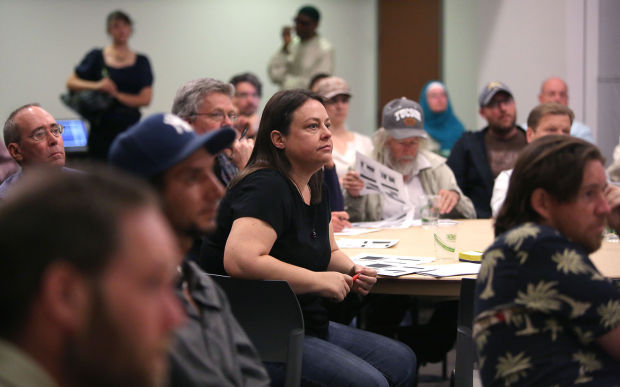Tucson police began posting notices Tuesday afternoon on tents and boxes lining downtown streets, notifying the homeless occupants they have until 6 p.m. Friday to remove the structures.
Police started posting the violation notices after a federal judge told city officials earlier in the day that nothing has prevented them from enforcing health and safety codes.
U.S. District Court Judge David C. Bury told city officials the structures are not recognized as an extension of the occupants’ free-speech rights.
The notices say the wooden boxes and tents are an obstruction of a public sidewalk.
The city has increasingly come under fire from the county and downtown business owners for doing nothing about the public-health concern from human waste deposited by occupants of more than 70 coffin-like crates they call “dream pods” and tents lining the streets around Veinte de Agosto Park and the Tucson Convention Center.
Although city officials have blamed Bury for an order they said limited their enforcement powers, the judge told city officials during a hearing Tuesday that any reluctance to enforce health and safety ordinances was the fault of the city.
“The city, according to the papers you filed, has chosen to do nothing,” Bury told Tucson City Attorney Mike Rankin and Assistant City Attorney Chris Avery at a Tuesday hearing in federal court.
The city had requested that Bury clarify his Dec. 22 preliminary injunction issued in conjunction to a lawsuit plaintiffs filed against the city by camp occupants.
Activists John Cooper and Jon McLane sued, saying their First Amendment rights were violated when the city denied overnight use of parks and police harassed them for protesting on sidewalks.
Bury’s December ruling said the city could not enforce the so-called “3-B policy,” referencing a city ordinance prohibiting protesters from having more than blankets, bottles and backpacks with them. Bury said the city could not use that, alone, to justify removing people from sidewalks and parks.
Since the ruling, dozens of homeless people flocked to the encampment, which organizers call “Safe Park.” It has extended outward from its origins adjacent to the park at Congress Street and Church Avenue to touch much of the west side of downtown.
Bury spent much of Tuesday’s 30-minute hearing upbraiding the city for its apparent misinterpretation of his order before saying the ruling was easily understood and in no need of clarification.
“Everybody agrees these pods are on the sidewalk not in furtherance of free speech,” Bury said, telling the city attorney that actions to remove the pods would not violate his order.
Rankin had previously told the Arizona Daily Star the city decided to act cautiously when enforcing city ordinances restricting people from living in public spaces such as downtown sidewalks after Bury’s order.
In its request for clarification, the city argued the proliferation of the homeless downtown, and the frequent urinating and defecating on sidewalks and other public spaces that has occurred as result, has created additional risks to public health and safety.
Bury, however, said the city has needlessly delayed or simply failed to address such problems.
“The city has offered no reasons why it can’t protect the interests of the city within the confines of this order,” he said. “The city delayed taking necessary measures to protect citizens.”
McLane said he wasn’t surprised. “If they think that we’re violating the law, the city has every right to act,” he said.
Interim Tucson City Manager Martha Durkin said the city has been working with social-service providers to locate housing for people living around the park. She said space for about 75 people has been found.
“We think that we have identified sufficient shelter for people who chose to take it,” Durkin said. Last month, many camp occupants declined offers of help from social-service agencies.
Durkin said any items left on the sidewalks or that police have to confiscate after the Friday deadline would be stored for up to 30 days.
Earlier Tuesday, about 50 representatives of nonprofit organizations, religious groups and the business community and homeless activists met to discuss how to solve the problems that drove people to the camp.
“Today there are no issues that are simple, they are all complex,” Roman Catholic Diocese of Tucson Bishop Gerald Kicanas said following the meeting.
Peggy Hutchison of the Primavera Foundation of Tucson said at least 10,000 people in the community experience either acute or chronic homelessness.
“The numbers are overwhelming, quite frankly,” Hutchison said, and require a more diverse approach to address the lack of housing and other problems.
Michele Ream, with Community Supported Shelters of Tucson, presented different examples of homeless shelters that have been used in other cities, such as sanctuary camps where tents and other temporary structures could be installed, transitional villages with micro-housing units about 120-square feet in size and cooperatives with permanent housing and shared facilities.






